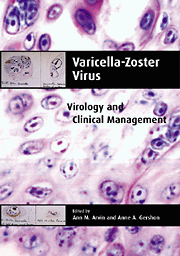Book contents
- Frontmatter
- Contents
- List of contributors
- Preface
- Introduction
- Part I History
- Part II Molecular Biology and Pathogenesis
- Part III Epidemiology and Clinical Manifestations
- Part IV Laboratory Diagnosis
- Part V Treatment and Prevention
- 18 Treatment of varicella
- 19 Treatment of herpes zoster
- 20 Management of postherpetic pain
- 21 Passive antibody prophylaxis
- 22 Development of the Oka vaccine
- 23 Primary immunization against varicella
- 24 Prevention of nosocomial transmission
- 25 Immunization against herpes zoster
- Index
- Plate section
21 - Passive antibody prophylaxis
from Part V - Treatment and Prevention
Published online by Cambridge University Press: 02 March 2010
- Frontmatter
- Contents
- List of contributors
- Preface
- Introduction
- Part I History
- Part II Molecular Biology and Pathogenesis
- Part III Epidemiology and Clinical Manifestations
- Part IV Laboratory Diagnosis
- Part V Treatment and Prevention
- 18 Treatment of varicella
- 19 Treatment of herpes zoster
- 20 Management of postherpetic pain
- 21 Passive antibody prophylaxis
- 22 Development of the Oka vaccine
- 23 Primary immunization against varicella
- 24 Prevention of nosocomial transmission
- 25 Immunization against herpes zoster
- Index
- Plate section
Summary
Historical background
Before antiviral drugs became available, the administration of passive antibodies to varicella-zoster virus (VZV) was evaluated for the prevention and treatment of varicella and herpes zoster. The cumulative observations made in these early studies identified specific indications to prevent and modify the severity of varicella, particularly in immunocompromised patients.
The first investigations of passive antibody preparations involved the transfusion of plasma obtained from patients convalescing from chickenpox to treat or prevent varicella and zoster. Plasma donors with recent VZV infections were used to ensure high titers of VZV IgG antibodies. Failure of high titer VZV immune plasma to impact the course of zoster might have been anticipated, as neither a delay in appearance of VZV antibodies nor their prompt appearance seemed to correlate with whether dissemination occurred (Miller & Brunell, 1970). In clinical studies, VZV immune plasma was ineffective for treatment of zoster (Groth et al., 1978) and in prevention of dissemination (Stevens & Merrigan, 1980). Moreover, the presence of VZV IgG antibodies in patients' plasma could be documented prior to onset of zoster (Miller & Brunell, 1970). It was apparent that the major use of passive immunization against VZV infections would be for the prevention of chickenpox.
With the development of immune serum globulin (ISG), the need to use plasma for prophylaxis of varicella diminished. Immune globulins have the advantage of delivering VZV antibodies in a smaller volume, with uniformity of titer and greater safety than plasma. Several reports about the use of ISG prophylaxis were published, but the landmark study was performed by Ross (1962). Children who had no history of chickenpox were given ISG prepared from varicella-immune donors.
- Type
- Chapter
- Information
- Varicella-Zoster VirusVirology and Clinical Management, pp. 428 - 441Publisher: Cambridge University PressPrint publication year: 2000
- 1
- Cited by



